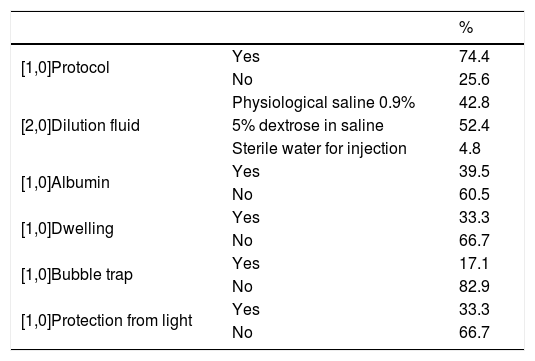Blood glucose abnormalities are a frequent problem in preterm newborns in neonatal intensive care units (NICUs). Specifically, the incidence of hyperglycaemia ranges from 25% to 75%, depending on the sample, the thresholds used for its definition and the frequency of blood glucose measurements.1 One of the factors involved in its development is insulin resistance secondary to a high circulating level of inflammatory markers, cytokines and catecholamines and a relative insulin deficiency associated with the production of proinsulin by immature beta pancreatic (10 times less active).2
Abnormalities in glucose homeostasis may have dire consequences. Some studies have found that hyperglycaemia is associated with an increase in mortality, which in turn is significantly associated with the duration of hyperglycaemia. There is also evidence that hyperglycaemia is associated with an increased incidence of retinopathy of prematurity and grade III and IV intraventricular haemorrhage.1,3 Therefore, it is necessary to make an accurate diagnosis and provide adequate treatment, which in this population usually consists of continuous intravenous insulin infusion.
Commercial insulin is a genetically engineered polypeptide that due to its molecular characteristics adsorbs to the glass and plastic of syringes and tubing that contain it. To date, there is a scarcity of scientific data on which method would be best to prepare insulin infusions. Some facilities add a variable amount of albumin to saturate the walls of the container and the infusion system and therefore minimise adsorption of insulin.4 There is also evidence that adsorption increases with low concentrations of insulin and with lower flow rates,4,5 and therefore the method used for preparation may have an impact on the actual dose delivered to the infant and result in variations in the therapeutic effect. Another factor that may affect the stability of the preparation is the duration of the contact of insulin with the surfaces of the infusion system, so some units use a pre-conditioning or dwelling time before initiating administration, using the same preparation or a more concentrated solution with the aim of saturating the system and reaching equilibrium.6 It is unclear whether protection against light exposure in insulin administration has an impact on stability. Lastly, the use of bubble trap filters, the total surface area of the system or the frequency with which infusion sets are changed may also have an effect on the final concentration of the administered insulin.3–6
At present there is no consensus on the optimal method to prepare and administer insulin infusions in the NICU setting. Because of this, we conducted a nationwide survey to assess the variability in the methods used to prepare insulin infusions in neonatal units in Spain. We used the software Google Forms® and disseminated the questionnaire through social media and sending it by email to the members of the Sociedad Española de Neonatología (Spanish Society of Neonatology).
We received a total of 44 responses from 44 Spanish hospitals with a NICU. Of these respondents, 80% were paediatricians and 20% nurses. Table 1 summarises the main results of the survey.
Results of the survey on the use of insulin infusions in neonatal units in Spain (n=44).
| % | ||
|---|---|---|
| [1,0]Protocol | Yes | 74.4 |
| No | 25.6 | |
| [2,0]Dilution fluid | Physiological saline 0.9% | 42.8 |
| 5% dextrose in saline | 52.4 | |
| Sterile water for injection | 4.8 | |
| [1,0]Albumin | Yes | 39.5 |
| No | 60.5 | |
| [1,0]Dwelling | Yes | 33.3 |
| No | 66.7 | |
| [1,0]Bubble trap | Yes | 17.1 |
| No | 82.9 | |
| [1,0]Protection from light | Yes | 33.3 |
| No | 66.7 |
The collected data evinced great variability in the preparation of infusions in aspects such as the fluid used for dilution, the pre-conditioning dwelling time, use of filters and protection from light. We ought to highlight that 25% of the units did not have a written protocol on how to prepare insulin infusions. We specifically asked if they used albumin in the preparation, and if they did, to note the amount added (albumin concentration, added mL, and total volume in mL of the preparation). Only a minority used albumin (37%), and we found substantial variability in the dosage in terms of both the volume and concentration of albumin used. The reported concentrations of albumin ranged from 0.1 to 0.2g per 50mL. Another finding that emerged in an open-ended question about the preparation protocol was that 7% of units used concentrated insulin solutions (5 IU/mL) to saturate syringes and tubing.
Our study confirmed the significant heterogeneity in the preparation of insulin infusions and thus the uncertainty in the reliability of the delivered treatment. Therefore, new stability studies are required to establish the optimal method for preparing and administering insulin infusions and allow standardization of a frequently used treatment that has a significant impact on the outcomes of preterm infants.
Conflicts of interestThe authors have no conflicts of interest to declare.
We want to acknowledge all the professionals that care daily for newborns in neonatal units throughout Spain and that contributed to the survey by completing the questionnaire. We also thank the Sociedad Española de Neonatología and the blog Cuidando Neonatos for their help in distributing the questionnaire.
Please cite this article as: García-Robles A, Solaz García A, Poveda-Andrés JL, Gimeno-Navarro A, Aguar-Carrascosa M. Preparación y administración de perfusiones de insulina en neonatología: Encuesta nacional. An Pediatr (Barc). 2021;95:48–49.




